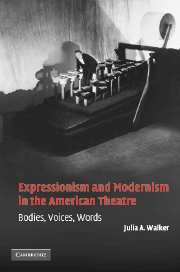Book contents
- Frontmatter
- Contents
- List of illustrations
- Acknowledgments
- Part I Introduction
- 1 Bodies: actors and artistic agency on the nineteenth-century stage
- 2 Voices: oratory, expression, and the text/performance split
- 3 Words: copyright and the creation of the performance “text”
- Part II Introduction
- Notes
- Works cited
- Index
2 - Voices: oratory, expression, and the text/performance split
Published online by Cambridge University Press: 22 September 2009
- Frontmatter
- Contents
- List of illustrations
- Acknowledgments
- Part I Introduction
- 1 Bodies: actors and artistic agency on the nineteenth-century stage
- 2 Voices: oratory, expression, and the text/performance split
- 3 Words: copyright and the creation of the performance “text”
- Part II Introduction
- Notes
- Works cited
- Index
Summary
In the back pages of an 1897 edition ofWerner's Magazine is an advertisement, pitched to the voice teachers and elocutionists who were the magazine's chief subscribers, for a device called a “graphophone” that combines the recording features of a dictaphone with the play-back features of a phonograph. The ad, shown in figure 4, depicts a panoply of artists floating on the waves of sound funneling from the machine's horn, and promises to assist teachers of “music, elocution … language, or … anything where accuracy of tone, inflection or pronunciation is important.” Touting that “exercises may be recorded on cylinders by the instructor,” and that “such a cylinder becomes at once a patient, tireless teacher, ever ready to repeat,” the ad goes on to claim that this instrument is “more valuable than any text-book, because it speaks to the ear with the living voice.” What's more, it adds, a permanent record of students' voices can be made. Clearly, the appeal here is to help ambitious vocal coaches extend their pedagogical reach beyond the sound of their own voice, proving Friedrich Kittler's observation that, by transforming bodily traces into material artifacts, these new communications technologies promised a kind of immortality. But they also helped to induce an element of anxiety by implying that, like John Henry and the locomotive, technology ultimately would be unmatched.
Information
- Type
- Chapter
- Information
- Expressionism and Modernism in the American TheatreBodies, Voices, Words, pp. 58 - 83Publisher: Cambridge University PressPrint publication year: 2005
